Of all the types of lizards within the Reptilia class, iguanas are among the largest and most majestic. If you’re considering adopting one as a pet or are simply captivated by these massive reptiles, you’ve probably wondered at some point: what do iguanas eat?
There are around 40 unique iguana species within the Iguanidae suborder, and most of them are herbivores, though a select few are omnivorous. The majority of known iguana species live throughout South or Central America in hot, humid climates where plant life is abundant, both as food and as shelter. What does all this mean for the typical iguana’s diet? Keep reading to learn more!
Are All Iguanas Herbivorous?
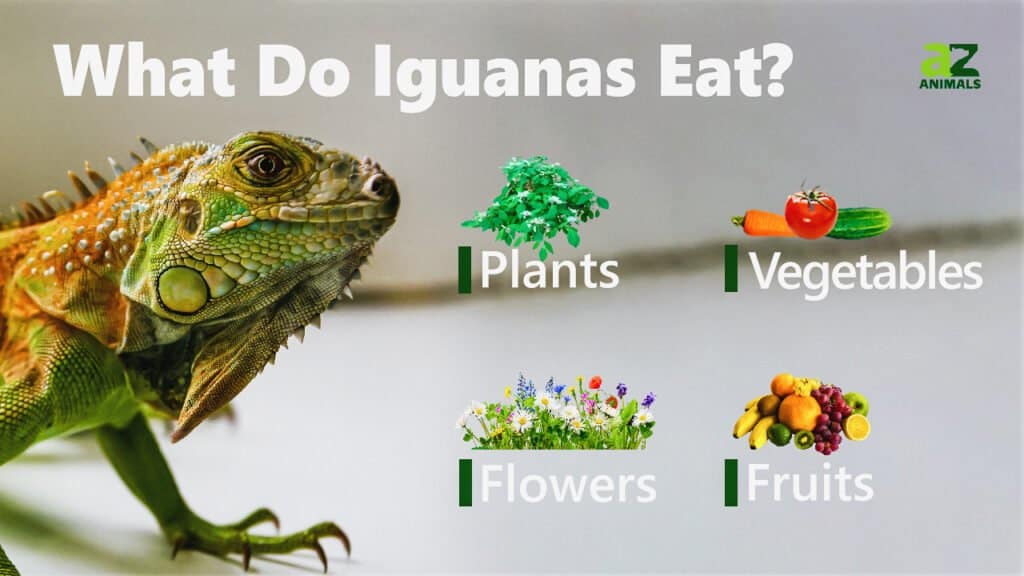
As mentioned above, the vast majority of the roughly 40 iguana species are herbivorous both in the wild and in captivity. More specifically, most of them are folivorous. A folivore is a type of herbivore that primarily feeds on leafy plant growth, though many iguanas also regularly consume fruit and other vegetables they come across in their native habitats.
For example, perhaps the most well-known iguana species, the green iguana, is an expert forager and is constantly searching for leaves, vines, fruits, and even flowers to munch on. In captivity, their diets are mostly the same, though pet green iguanas typically get more variety in their meals since they aren’t confined to one small area’s specific plants.
Many water-loving species of iguanas, such as the marine iguana, are strong swimmers and also look to bodies of water to find plants to feed on. They will commonly feed on various types of algae and seaweed in addition to the leafy plants and flowers they come across on land.
What Are Wild Herbivorous Iguanas’ Favorite Foods?
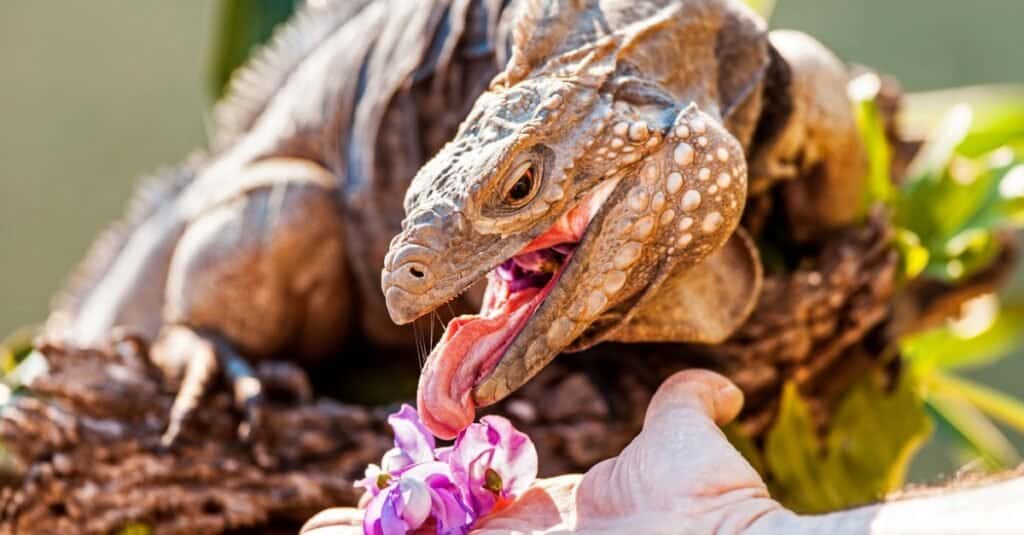
Grand Cayman
blue iguanas
enjoy eating flowers.
©iStock.com/adogslifephoto
Most herbivorous iguanas, such as green iguanas, blue iguanas, and rock iguanas aren’t very picky about the plant material they choose to eat.
Since the majority of iguana species live in mostly tropical and subtropical regions where plant life is abundant, they have a wide range of foods to choose from. However, some of their favorite foods they actively seek out in the wild include:
- Flowers like hibiscus, roses, and orchids
- Leafy vines like the princess vine and balloon vine
- Flowering vines like the bougainvillea
- Tropical fruits like melons, mangoes, figs, and papaya
- Umbrella plants
- Nettles
- Leaves of various fan palms
- Dark, leafy vegetable greens found in gardens
- Vegetables like squash and tomatoes (also found in gardens)
- Various other small fruit and flower-bearing shrubs
Do Any Iguanas Eat Meat or Insects?
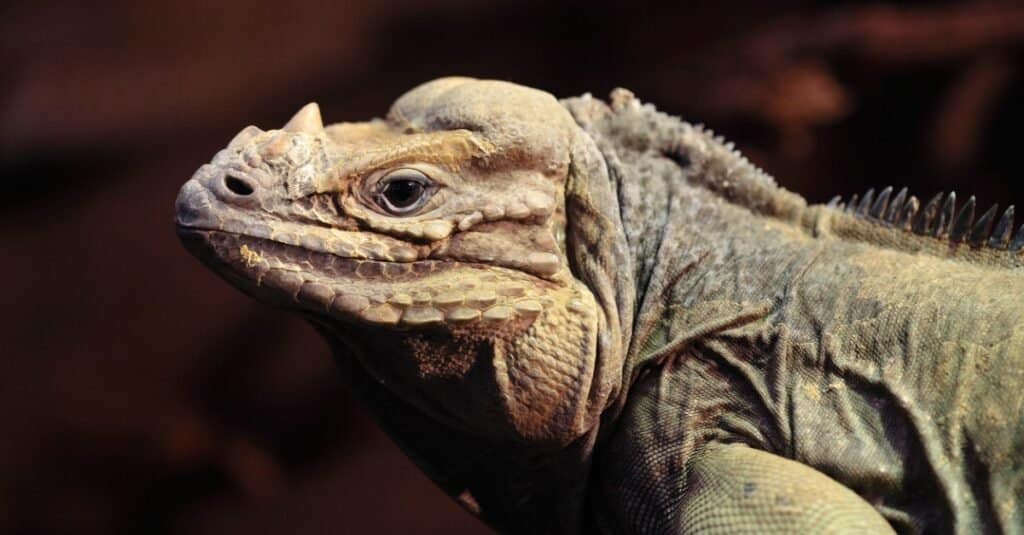
Rhinoceros
iguanas are one of the rare omnivorous iguana species.
©iStock.com/erllre
Although the majority of known iguana species are primarily herbivorous, there are still several notable species that also consume insects and even other animals like lizards and frogs in their native habitats!
For example, the rhinoceros iguana is mostly herbivorous in the wild, but it is technically an omnivore. They will commonly eat small insects and arachnids in addition to plant material. In rare cases, though, they will also eat smaller lizards and even snakes when they are desperate and their other primary food sources are scarce.
Spiny-tailed iguanas are another highly opportunistic and omnivorous group of iguana species in the wild. These South American iguanas feed on plenty of plant material, mostly in the form of leafy plants and vines. However, they also will eat insects, arachnids, and various kinds of eggs from other lizards and birds.
When it comes to a more strictly meat-based diet, though, there are no 100% carnivorous iguanas. Virtually all species eat either solely plant material or a combination of plant material and animal matter.
What Are Wild Omnivorous Iguanas’ Favorite Foods?
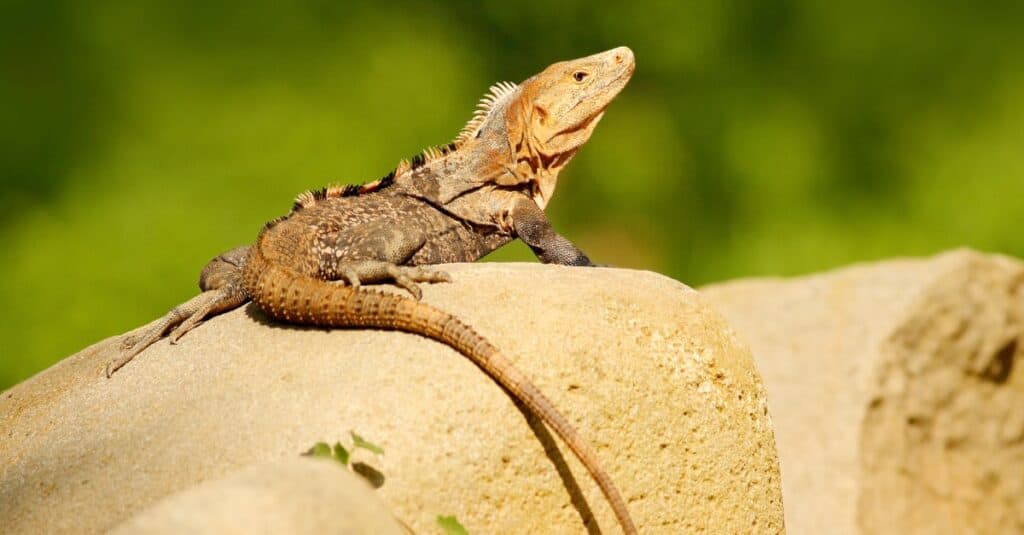
The black spiny-tailed iguana is another omnivorous and highly opportunistic species in the wild.
©iStock.com/Ondrej Prosicky
Omnivorous iguana species are perhaps even less choosy with their diet than herbivorous species! In fact, most of them are highly opportunistic and will eat any plant or animal small enough to get into their mouths without a struggle.
Since most omnivorous iguanas are fairly large lizards, they have a variety of foods to choose from in the wild. Their favorite things to eat include:
- Small-to-medium-sized insects like beetles, roaches, and caterpillars
- Land and water-dwelling arachnids, including spiders, crabs, and even scorpions
- Small bird, lizard, and turtle eggs
- Other lizards like small geckos
- Hatchling birds, lizards, and turtles
- Small fish and fish eggs
In addition to these meat-based foods, omnivorous iguanas also enjoy many of the same favorite foods as herbivorous iguanas. These foods include various flowers, fruits, and other leafy plants.
What Do Pet Iguanas Eat?
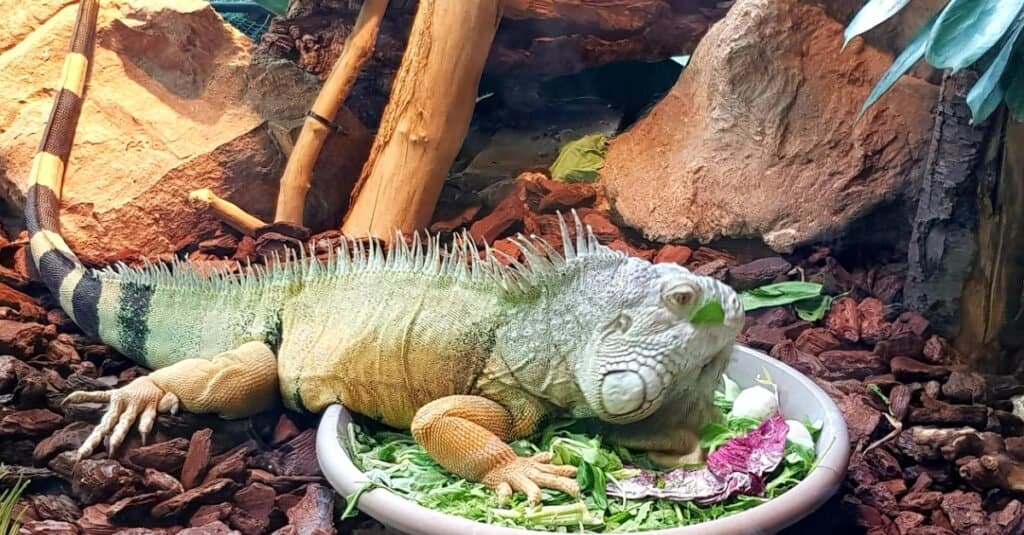
Green iguanas in captivity should be fed a wide variety of different greens, vegetables, and fruits.
©iStock.com/Suzana Dreno
Iguanas are a challenging type of reptile to keep as pets, as most species are very large, difficult to handle, and require enormous enclosures with very specific temperature and humidity settings. In addition to their substantial housing requirements, pet iguanas also must eat large amounts of food each day, mostly in the form of fresh greens, vegetables, and fruits. Most omnivorous species also must ingest a fair amount of insect protein to stay healthy and happy in captivity.
Still, many iguana species are commonly kept in captivity by expert reptile hobbyists who are up to the task and able to keep up with the giant lizards’ feeding and housing costs. Some of the most popular species often kept as pets include the green iguana, rhinoceros iguana, and desert iguana.
In captivity, herbivorous iguanas are typically given foods such as:
- Dark, leafy greens like collard, turnip, and dandelion greens
- Various safe flowers like hibiscus, roses, and orchids
- Leafy ornamental plants
- Vegetables like squash, bell peppers, and carrots
- Sweet, juicy fruits like melons, mangoes, and berries
Omnivorous iguanas, on the other hand, typically eat the aforementioned plant material in addition to small amounts of the following meat-based foods:
- Crickets and locusts
- Mealworms and superworms
- Various small yet protein-rich bird eggs (chicken, quail, etc.)
- Dubia roaches
- Hornworms
Most captive iguanas are also offered a calcium supplement, usually in powdered or liquid form. These supplements are designed to be sprinkled on top of plant material or animal protein like insects. They also sometimes contain other vitamins iguanas benefit from in captivity, such as vitamin D3.
What Foods Are Toxic to Iguanas?
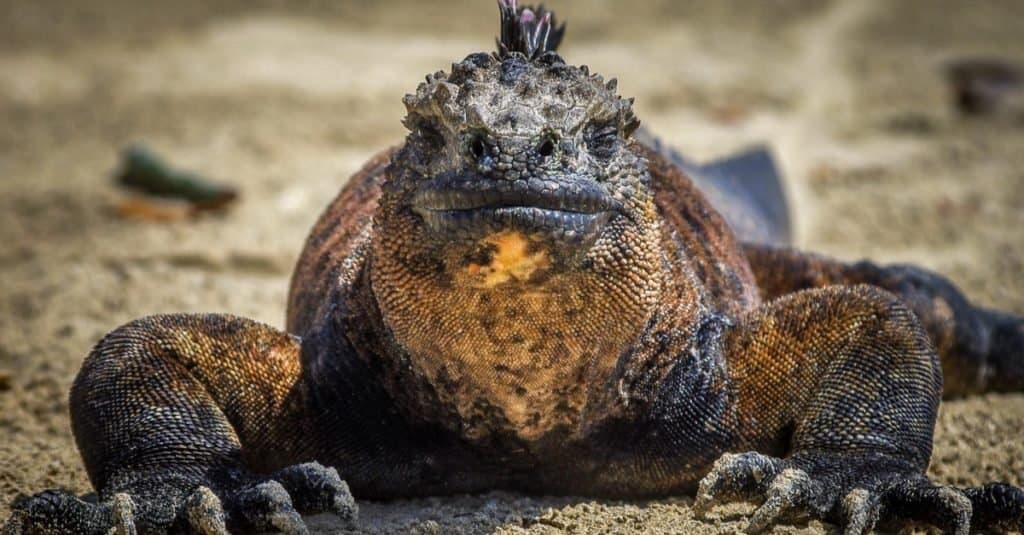
Strictly herbivorous iguanas such as the marine iguana cannot eat animal protein.
©Original Mostert/Shutterstock.com
While most iguana species are opportunistic and therefore not very picky when it comes to what they eat, there are certain toxic or harmful foods they shouldn’t eat, regardless of whether they’re in the wild or kept as pets.
For herbivorous iguanas like green iguanas, all forms of animal protein must be avoided. This means they can’t eat eggs, insects, arachnids, or other lizards, for example. This is because their digestive tracts are unable to break down animal matter.
Plant material high in oxalates, also known as oxalic acid, is also toxic in large amounts. Oxalates interfere with both herbivorous and omnivorous iguanas’ absorption of calcium and other important nutrients.
Most fruits are somewhat high in oxalates. Because of this, only around 15% of an iguana’s diet should be made up of fruit. Certain greens like spinach, beet greens, and rhubarb also contain dangerously high levels of oxalates.
Finally, any processed “human foods” high in fat, sugar, or carbohydrates can make both herbivorous and omnivorous iguanas very sick, even in small amounts. Iguanas’ digestive tracts and gut bacteria also cannot break down or benefit from these foods in any way.
The photo featured at the top of this post is © iStock.com/adogslifephoto
Thank you for reading! Have some feedback for us? Contact the AZ Animals editorial team.







